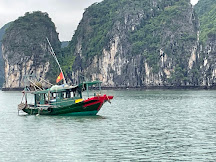A NECESSITY.jpg) |
| Egg Coffee, Hanoi |
To say we are coffee
snobs is an understatement. We have Diamond Head Roast from Lion Coffee shipped
in from Oahu monthly. When we travel, we like to visit coffee plantations.
Janet is comatose without
her daily cup, and I’ve given up trying to move her along first thing in the
morning. Personally, I have drunk so much coffee in my life I’m practically
immune to the effects of caffeine. I’ve been known to drink a cup of coffee at night
and then go to sleep.
Part of the joy in
traveling is drinking coffee like the locals, whether it’s a strong bitter
Italian espresso standing at a café bar, or a Barriquito while relaxing at a Tenerife
seaside café. At home we have a milk frothing device and a chorreador from Costa Rica
and a cold drip glass contraption. We can roast our own beans. Of course we
have a French Press…please.
LION COFFEE, HONOLULU
HISTORY
Vietnam is the world’s largest
exporter of Robusta coffee and the second largest producer of coffee in the
entire world after Brazil. The first Arabica coffee plants were brought to the
country by French missionaries in the mid-1800s and thrived in the warm humid
climate. At the turn of the century the Robusta coffee bean was introduced and
in the central Highlands coffee became a cash crop and spurred a thriving
industry, especially after the Doi Moi reforms began in 1986 and the Communists
allowed private enterprise coffee.
JITTERY?
 |
| a phin hard at work |
But enough of history! The Vietnamese
love their coffee as much as we do, and it is impossible to get a bad cup anywhere.
The most popular way of drinking the elixir of the gods is Cà phê sua dá, or
Iced Milk Coffee, which doesn’t sound any different than what we get at home. It
is in the preparation though that makes this Vietnamese ambrosia stand apart.
PHIN ME
Each cup is individually
brewed with a Vietnamese Phin drip filter that sits atop a glass with condensed
milk. Ground Robusta coffee is put in the Phin, pressed down to compact it and
then hot water poured in and allowed to drip slowly creating a strong brew. The
ratio of coffee to condensed milk is personal to taste. Add ice! On a hot day
this is quite refreshing. It’s great even without condensed milk, or without
ice.
SPECIALTY COFFEE
Cà phê sua dá is used as the
base for specialty coffees, and nearly every town we visited during our recent
trip to Vietnam had their own twist on this very very necessary divine nectar.
Here’s a list of the coffees we tried.
Hanoi:
Egg Coffee –
Invented by the bartender at
the Sofitel Legend Metropole Hotel in the mid-40s. Fresh milk was scarce then,
but he discovered that whipped egg yolks created a delicate froth that combined
well with condensed milk and coffee. The concoction was a hit, and he left the
hotel to open Café Giang that is now run by his son.
The egg yolks need to be thoroughly
beaten and are “cooked” by the hot coffee reducing any food concerns.
Coconut Coffee -
 |
| Coconut coffee |
Brain freeze! This indulgent drink
combines strong Vietnamese coffee with coconut milk and a splash of condensed
milk to make this a tropical flavor that you will gulp down on a hot afternoon
(we did). Topped with toasted coconut shavings! Oh my.
Hue
Salt Coffee -
This is very popular in Hue,
the former capital of Vietnam. At first this strong coffee combined with
condensed milk and topped by a salted cream seemed like an odd combination, but
on a hot sweaty afternoon in Hue it was surprisingly refreshing.
 |
Salt coffee, Hue
|
Hoi An
Durian Coffee -
 |
| a Durian |
In this UNESCO heritage city,
the city of lanterns, we had coffee mixed with the notorious Durian fruit. Durian
has a strong, noxious smell, but combined with coffee was okay.
Nha Trang
Flan coffee-
.JPG) |
Flan coffee,
Nha Trang |
Across the street from the Em
Oi Hotel, where we stayed while visiting the very touristed town of Nha Trang
is the Café Here. It was here we had Flan coffee which is literally a flan
floated atop a creamy strong coffee. Vietnamese flan differs from Mexican in
its firmer denser consistency but makes a surprisingly wonderful coffee!
Black Iced coffee at the
Birdwatching Café
A stop during our tour of Nha
Trang, a popular resort with Russian and Chinese tourists, was the Birdwatching
Café. No more than an empty lot where men would come with their pet birds and
hang the cages so the birds could chatter as they had a coffee.
 |
Black coffee at the
Birdwatching Cafe |
We were offered coffee with or without condensed milk, over ice. I chose black.
THE REAL SHIT
Dalat
The Asian Palm Civet is like a
weasel, and it shits out coffee beans. Back during the colonial times coffee
became a cash crop for the French and the Vietnamese working the farms were not
allowed to drink the profits. These workers discovered partially digested
coffee beans in the poop of the civet. Rinsing them off and preparing them the
workers found the coffee was better than beans taken directly from the plant. Turns
out the civet has a very discerning palate and will only eat the ripest coffee
cherries. Unripe beans or even beans from a sick tree will not be touched.
The actual coffee bean is in
the middle of the cherry. As the beans pass through the digestive tract they
are partially fermented and altering the taste.
 |
| Weasel shit coffee |
Shit-faced?
The coffee is rich and smooth,
but only if you can get beyond thinking about the processing of the bean. Collecting
weasel poop is labor intensive and the cost reflects this. We visited the Ca
phe chon in the central highlands near Dalat to see their 5-acre organic farm with
150 captive civets in massive enclosures to witness the first step in this coffee
adventure. We then got to sample the end product with our own phin.
The people of Vietnam have
been known to eat Civets and poaching is a problem. There is also a process of
fermenting the beans without the use of civet’s GI tract, mimicking closely the
flavor.
I bought a small bag of coffee from Ca Phe Chon Dalat to bring home. It was the most expensive item I purchased in my
entire trip to the country.
CA PHE CHON DALAT
Time for a coffee break.
Thanks for reading.
Love Janet and greg
© 2024 by Gregory Dunaj

















.jpg)
.jpg)





.JPG)
































